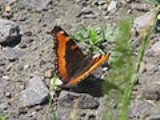
Aglais milberti
Encyclopedia
Milbert's Tortoiseshell (Aglais milberti), also known as the Fire-rim Tortoiseshell, is the only species of Aglais
that occurs in North America
.
and Alaska
south of the tundra
, all of the western United States
and most of the eastern United States
. In these areas they commonly occur in wet areas, including moist pastures, marshes, most trails and roadsides.
caterpillars eat together in a web, but later instars feed alone. They hibernate as adults, often in small congregations. Adults have been known to mate in low-elevation watercourses in arid regions.

Aglais
Aglais is a genus of brush-footed butterflies, containing the Tortoiseshells. This genus is sometimes included as a subgenus of Nymphalis, which also includes Tortoiseshells, but it is usually considered to be separate.-Species:...
that occurs in North America
North America
North America is a continent wholly within the Northern Hemisphere and almost wholly within the Western Hemisphere. It is also considered a northern subcontinent of the Americas...
.
Description
The wingspan is between 4.2 and 6.3 cm and the forewing's tips are squared off. The upperside is black with wide orange submarginal bands; this orange slightly fades to yellow near the inner edge. Both wings have narrow black marginal borders; the hindwing may have blue spots.Behaviour
This is a quick species that flits rapidly around woodland roads. When it lands it may open its wings, often on trees or rocks.Range and Habitat
Milbert's Tortoiseshell's range includes all of CanadaCanada
Canada is a North American country consisting of ten provinces and three territories. Located in the northern part of the continent, it extends from the Atlantic Ocean in the east to the Pacific Ocean in the west, and northward into the Arctic Ocean...
and Alaska
Alaska
Alaska is the largest state in the United States by area. It is situated in the northwest extremity of the North American continent, with Canada to the east, the Arctic Ocean to the north, and the Pacific Ocean to the west and south, with Russia further west across the Bering Strait...
south of the tundra
Tundra
In physical geography, tundra is a biome where the tree growth is hindered by low temperatures and short growing seasons. The term tundra comes through Russian тундра from the Kildin Sami word tūndâr "uplands," "treeless mountain tract." There are three types of tundra: Arctic tundra, alpine...
, all of the western United States
United States
The United States of America is a federal constitutional republic comprising fifty states and a federal district...
and most of the eastern United States
United States
The United States of America is a federal constitutional republic comprising fifty states and a federal district...
. In these areas they commonly occur in wet areas, including moist pastures, marshes, most trails and roadsides.
Life cycle
There are two broods from May to October. During this time adults mate and lay eggs. The female will lay her eggs in bunches of up to 900 individuals on the underside of the host plant's leaves. Early-instarInstar
An instar is a developmental stage of arthropods, such as insects, between each molt , until sexual maturity is reached. Arthropods must shed the exoskeleton in order to grow or assume a new form. Differences between instars can often be seen in altered body proportions, colors, patterns, or...
caterpillars eat together in a web, but later instars feed alone. They hibernate as adults, often in small congregations. Adults have been known to mate in low-elevation watercourses in arid regions.
Adult foods

- Nectar
- ThistleThistleThistle is the common name of a group of flowering plants characterised by leaves with sharp prickles on the margins, mostly in the family Asteraceae. Prickles often occur all over the plant – on surfaces such as those of the stem and flat parts of leaves. These are an adaptation that protects the...
- GoldenrodGoldenrodSolidago, commonly called goldenrods, is a genus of about 100 species of flowering plants in the family Asteraceae. Most are herbaceous perennial species found in the meadows and pastures, along roads, ditches and waste areas in North America. There are also a few species native to Mexico, South...
- Lilac
- Thistle
- Plant sapPlant sapSap is a fluid transported in xylem cells or phloem sieve tube elements of a plant. It transports water and nutrients throughout the plant....
- Rotting Fruit
- Dung

